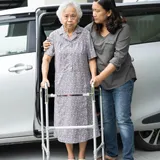Overview
Ovarian cancer begins in the ovaries, which are small organs in the female reproductive system where eggs are made. It can be hard to detect because symptoms usually do not show up until the cancer has spread. Treatment often includes surgery, chemotherapy, and other cancer therapies.
Ovarian cancer happens when abnormal cells in the ovaries or fallopian tubes grow too fast and form a tumor. These cells can spread and damage healthy tissue in the body. The ovaries are two small organs on either side of the uterus that produce eggs and female hormones like estrogen and progesterone. Although each ovary is about the size of an almond, cancer that starts here can grow quickly and be hard to detect in the early stages.
This type of cancer usually develops in the tissues of an ovary but may also begin in the fallopian tubes. It can be difficult to catch early because symptoms often appear only after the cancer has spread. Doctors treat ovarian cancer with surgery to remove the tumor and chemotherapy to kill cancer cells. In some cases, other treatments may be added depending on how far the cancer has progressed.
The type of cell where ovarian cancer starts helps determine the kind of cancer you have and guides your doctor in choosing the right treatment. There are a few main types of ovarian cancer:
- Epithelial Ovarian Cancer: This is the most common type of ovarian cancer. It includes several subtypes, such as serous carcinoma and mucinous carcinoma.
- Stromal Tumors: These are rare tumors that often get diagnosed earlier than other types of ovarian cancer.
- Germ Cell Tumors: These uncommon cancers usually develop at a younger age.
Risk Factors
Several factors may raise your risk of developing ovarian cancer. Some are linked to your age or family history, while others are related to lifestyle or health conditions. Understanding these risks can help you talk with your doctor about your health and possible screening options.
- Older Age: The chance of getting ovarian cancer increases as you age. Most cases are diagnosed in people over the age of 50.
- Inherited Gene Changes: Some gene changes passed down from your parents, such as BRCA1 and BRCA2, can raise your risk of ovarian and breast cancer. Other gene changes, like those related to Lynch syndrome, BRIP1, RAD51C, and RAD51D, may also play a role.
- Family History: If close relatives, such as your mother, sister, or daughter, have had ovarian cancer, your risk may be higher.
- Being Overweight or Obese: Having extra body weight has been linked to a greater chance of developing ovarian cancer.
- Hormone Replacement Therapy: Using hormone therapy after menopause, especially for a long time, may slightly increase your risk.
- Endometriosis: This condition causes tissue like the lining of the uterus to grow outside of it, which may raise the risk of ovarian cancer.
- Menstruation Timing: Starting your period early or going through menopause late means longer exposure to hormones, which may increase risk.
- Never Being Pregnant: People who have never been pregnant may have a slightly higher chance of developing ovarian cancer.













